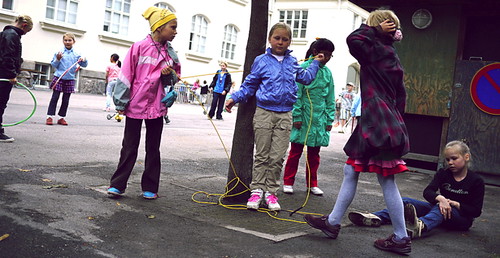The world’s educators will be watching the upcoming 2012 OECD Programme for International Study Assessment (PISA) results, and many Western countries will have their eyes on Finland. For a country that prides itself on prioritizing equity over competition, promoting ample outdoor play between classes, and eschewing standardized testing — Finland has surprised many industrialized countries by skyrocketing to the top of global education rankings over the last decade.

With only about 5.5 million total population, Finland ranked third overall behind huge STEM education powerhouses Shanghai-China and Korea, known for their grueling school days, high-pressure standardized testing, and competitiveness-boosting after-hours tutoring sessions. In fact, Finland was the only non-Asian country among the top five scorers, surprising the world — not least of all, Finland, a country where there are no rankings, competition, or comparisons between students, schools, teachers, or regions.
In the 2009 PISA, Finland came in second in science, third in reading, and sixth in math among nearly half a million students worldwide. So what’s their secret? Pasi Sahlberg, director of the Finnish Ministry of Education’s Center for International Mobility, has been in such high demand to visit inquiring nations that he has written a book: Finnish Lessons.
Some Finland education facts:
- All students in Finland receive a free education from when they start at seven years of age until they complete their university studies.
- The Finnish believe there is no reason to rush a child into school before the age of seven, pre-school for all 5-year-olds is free and play-based, and women have three years of maternity leave.
- There are no private schools or universities in Finland.
- 93% of Finns graduate from academic or vocational high schools — 17.5 percentage points higher than the U.S., and 66% go on to higher education, the highest rate in the European Union.
- Though Finland is still considered relatively homogenous, at least some elementary-level schools report that more than half of their students are recent immigrants from countries like Somalia, Bangladesh, and Iraq.
- In 1979, education reformers required that all teachers earn a fifth-year master’s degree from a state university, at state expense. All teachers are chosen from the top 10% pool of graduate students. Teachers in Finland have unprecedented autonomy, can form instructional partnerships freely, and are revered at the same level as doctors and lawyers.
And, with recent news that President Barack Obama is planning to launch a national STEM “Master-teacher corps,” the U.S. may very well be taking a few notes from the lesson book of Finnish education.
Creative Commons Love: Juan Freire and Claudio.Ar on Flickr.com


















Comments